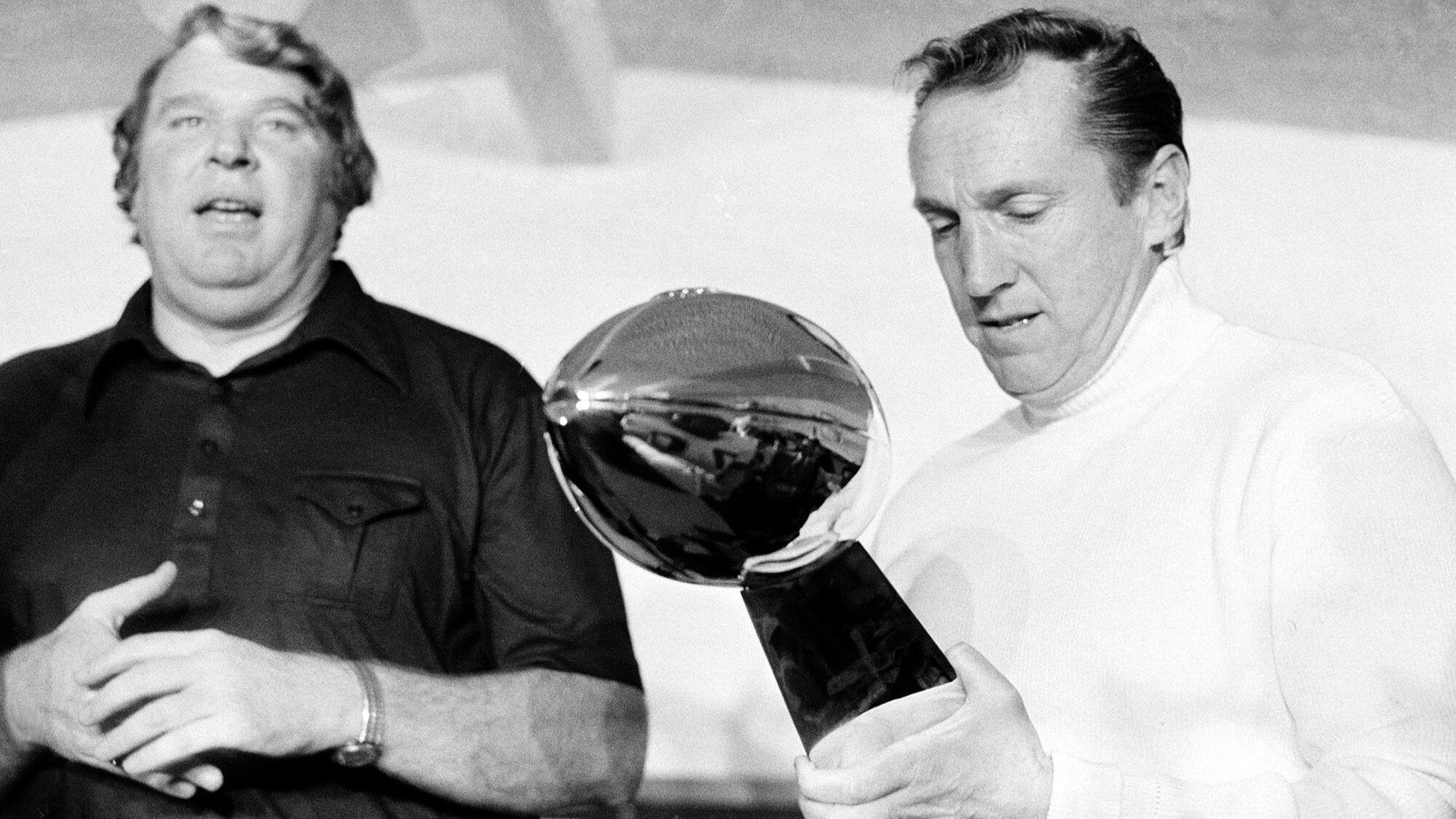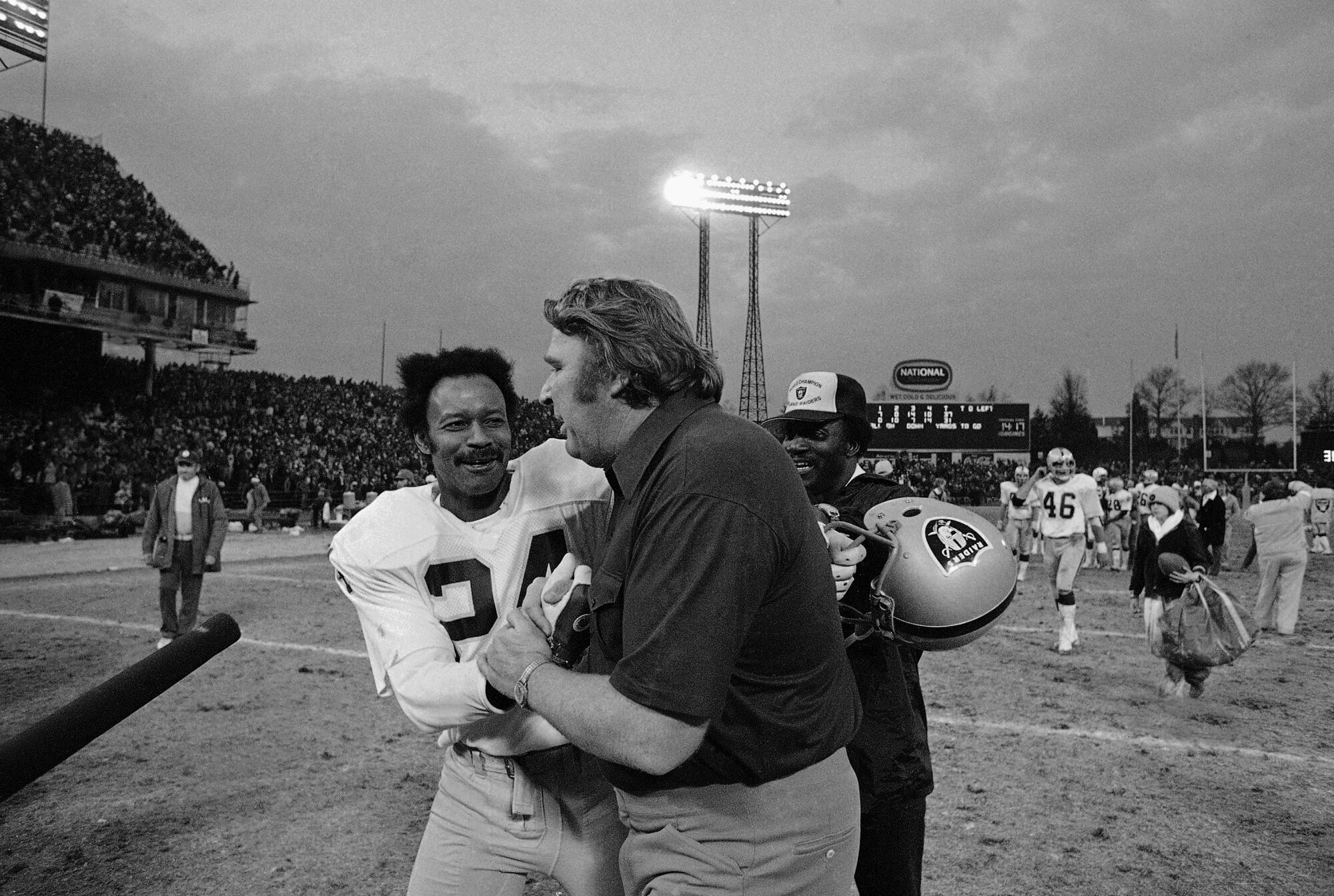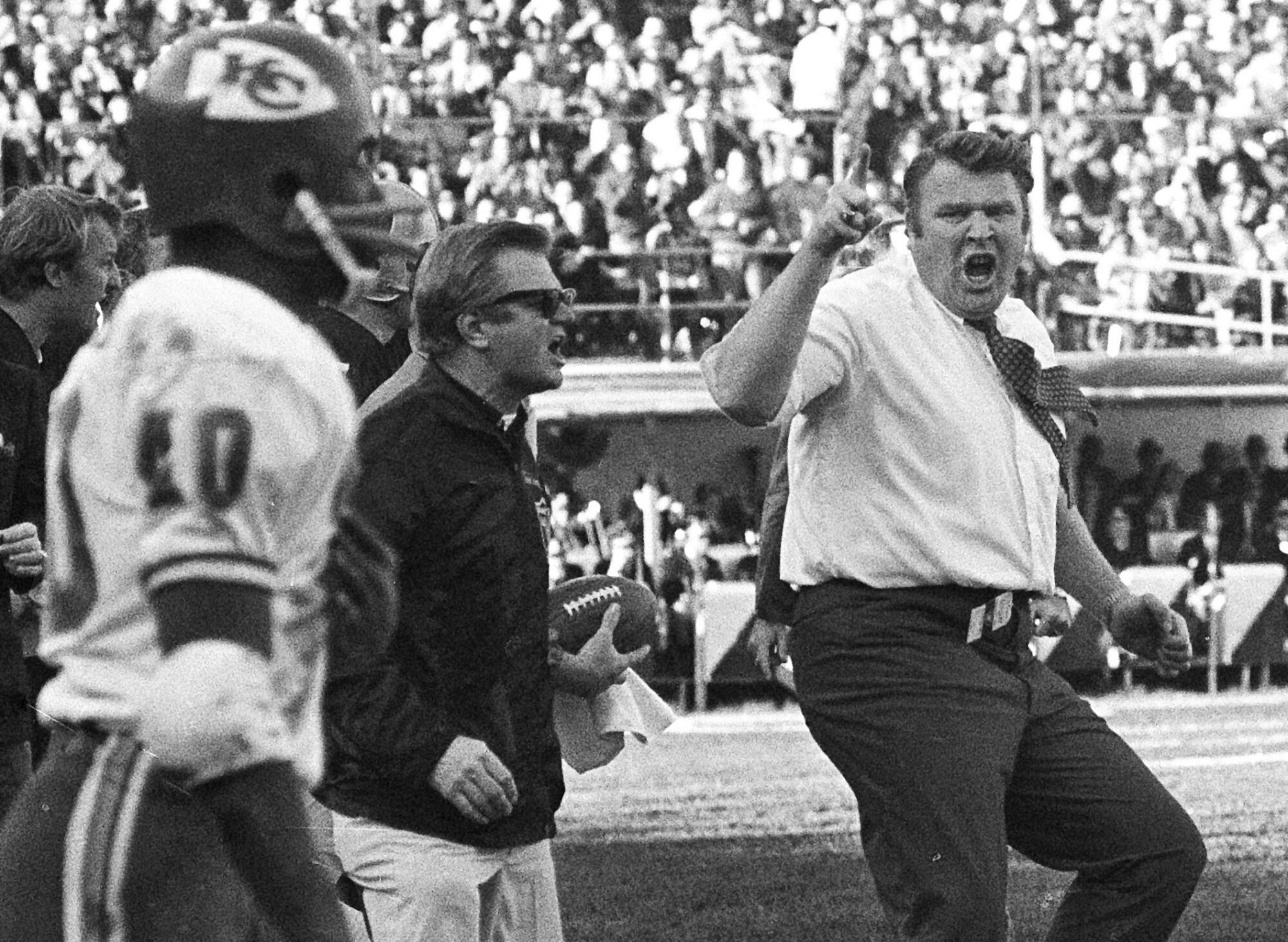
NFL legend John Madden, who reached the top of his profession in coaching, broadcasting and video games, died unexpectedly Tuesday at age 85.
- Share via
John Madden answered to three distinct names, each coming from a different generation of NFL fans.
He was “Coach” to the people who followed his Super Bowl-winning Oakland Raiders, “John” to the millions who remembered him best as a broadcaster and “Madden” to the legions of video-game devotees.
“I can always tell how somebody knows me,” he told The Times in 2005. “Some guys will call me coach, and then some people will just call me Madden. `Hey, Madden! Hey! Hey!’ That’s the game. They play Madden, and then they see Madden. `Hey, there’s Madden!’”
Madden, who reached the top of his profession in three different fields, died unexpectedly Tuesday. He was 85.
“On behalf of the entire NFL family, we extend our condolences to Virginia, Mike, Joe and their families,” NFL Commissioner Roger Goodell said, referencing Madden’s wife and their sons. “We all know him as the Hall of Fame coach of the Oakland Raiders and broadcaster who worked for every major network, but more than anything, he was a devoted husband, father and grandfather.
“Nobody loved football more than Coach. He was football. He was an incredible sounding board to me and so many others. There will never be another John Madden, and we will forever be indebted to him for all he did to make football and the NFL what it is today.”
Put simply by producer Fred Gaudelli, who worked with him on both Sunday and Monday Night Football: “He was a treasure, man. America lost a treasure.”
Said David Baker, former president of the Pro Football Hall of Fame: “In my past tenure as president of the Pro Football Hall of Fame, I was privileged to meet all the great legends of the game but can state ... that I have never met anyone who loved the game more that John Madden.
“He loved the game and all those who played it and we loved him because he helped us love the game more.”

Born John Earl Madden on April 10, 1936, in Austin, Minn., Madden was the son of an auto mechanic who moved his family to Northern California in 1942 in hopes of a better life.
Madden was raised in Daly City, and as a teen worked as a caddie at San Francisco Golf Club, quickly realizing he would need a college education to succeed in life. He was a good athlete and earned a football scholarship to the University of Oregon, spending a year in Eugene as a pre-law student. Because a knee injury cost him his football season, and he didn’t really enjoy his pre-law studies, he gave up his scholarship and returned to the Bay Area.
Switching his major to education, Madden briefly attended College of San Mateo and Grays Harbor College before enrolling at Cal Poly San Luis Obispo, where he resumed his football career. He was a two-year starter on the offensive and defensive lines, and played catcher on the baseball team. He was selected by the Philadelphia Eagles in the 21st round of the 1958 NFL draft, and spent one year as a professional before another knee injury ended his playing career.
John Madden offers five decades of reflection on the NFL
Madden returned to Cal Poly to earn his master’s degree in education. There, he met his future wife, Virginia Fields, who also was studying for her master’s degree. They married and had two sons, Joe and Mike.
Madden had begun coaching, first as an assistant at Allan Hancock Junior College, then two seasons as head coach. He would parlay that into a job as defensive coordinator at San Diego State University.
There, he caught the eye of Oakland Raiders owner Al Davis, who hired him to coach the team’s linebackers in 1967. The Raiders made the Super Bowl in his first season, losing to the Green Bay Packers. After the following season Raiders coach John Rauch quit, believing the owner was too meddlesome, and Davis promoted the 32-year-old Madden, making him the youngest head coach in American Football League history.
“Who the heck names a guy 32 years old as a head coach?” Madden said in 2006 in his induction speech at the Pro Football Hall of Fame. “Al Davis did. But he not only named me head coach, he stood behind me and he helped me and he provided me with players, with great players. As he was saying, nine of the players are in the Hall of Fame. I mean, those are the types of players that he provided me with.”
In his 10 seasons as coach of the Raiders, Madden led the club to seven Western Division titles, seven seasons with double-digit victories, and eight playoff appearances. In the 1976 season, his Raiders punctuated their 13-1 season by beating the Minnesota Vikings in Super Bowl XI.
Madden was carried off the field by his players after that victory — well, at least part of the way — a moment he recalled in his Hall of Fame speech.
“I was told it took like five or six guys to lift me up, then they dropped me,” he said. “But that’s OK, because that was me and that was them. They aren’t going to carry me off. You carry him off for a while, boom, you dump him on the ground. But it was the happiest moment of my life.”

There was a boyish and bumbling charm to Madden as he stormed up and down the sideline, flailing his massive arms as he pleaded his case with officials. He was the somewhat comical antithesis to the dapper, reserved Tom Landry in Dallas, and a perfect fit for the renegade Raiders.
“John’s strong suit as a coach was how he handled players,” the late Raiders quarterback Ken Stabler told the San Francisco Chronicle in 2006. “He knew football, of course, but we had such a group of free spirits, with different egos and different lifestyles. He acknowledged the fact it was a diverse group.
“I always remember John’s two rules: Be on time and play hard. There were no dress codes, no haircut rules. Because he treated us that way, nobody abused it.”
Madden’s tenure with the Raiders ended abruptly after the 1978 season, when he retired from coaching because of a bleeding ulcer and a strained relationship with his sons. He finished with a record of 103-32-7.
Shortly after his coaching career ended, Madden moved to the announcing booth, where he worked as a color analyst — some say the best ever — from 1979-2008 for all four major networks.
Although he was remarkably observant and knew football as well as anyone, he spoke to the common fan and was known for his cartoonish exclamations to describe what he saw.
“That’s how his unabashed passion for the game seeped out of him, with `Boom! Bam! Whap!’” said Gaudelli, Madden’s producer with “Monday Night Football” on ABC, then NBC’s “Sunday Night Football.”
“All the sounds that he had heard for so many years being a player in high school and college, being on the sideline for all those years as a coach. John was big on sound in general. He thought that we didn’t capture the sound of the game as well as it could be captured. He really worked with everyone to do a better job of that. In his natural form of exuberance, he provided his own sound effects for the soundtrack. No one had ever done that, and it was just fun. “
The broadcast team of Madden and Pat Summerall worked together for 22 years, including a record eight Super Bowls. Later, Madden teamed with play-by-play man Al Michaels before retiring from the booth in 2009.
“He had a genuineness and a transparency,” Michaels told The Times. “And when you saw John you knew that’s John. That’s not John acting as somebody else. That was John Madden. What you saw was what you got.”
“John was arguably the most impressive man I’ve ever met,” said former NBC Sports chairman Dick Ebersol. “He was a hero, as well as a dear friend.”
A lot changed in a year. These numbers show how.
Hall of Fame quarterback John Elway said players looked at Madden differently than they did other announcers, and they often took what he said to heart.
“When John Madden says it, you don’t really take it as criticism, you kind of critique it to figure out whether he’s right or wrong,” Elway told The Times. “With other guys you might say, `Well, that’s not right.’ If he said it, it kind of made you think twice because of the respect that he had.
“He had a great way of communicating the game to where as a player it never felt like he was being offensive. He was getting the message across to the fans, but he wasn’t doing it at the expense of the players.”
In addition to his announcing, Madden was a ubiquitous product pitchman, appearing in commercials for Miller Lite, Ace Hardware, Outback Steakhouse, Tinactin and many others. He had his own production studio in Pleasanton, near his home, so he never had to travel far to shoot an ad.
When he hit the road, Madden didn’t fly. Instead, he rode the “Madden Cruiser,” a luxury, customized bus in which he would zig-zag across the country. There are two theories about Madden’s fear of flying. He once said he felt claustrophobic in a plane. Others point to the plane crash in 1960 involving the Cal Poly football team, in which 16 players were killed, along with a student manager and a booster. Although Madden wasn’t on that flight — he had graduated two years earlier — he knew many people who were.
Financially speaking, his most successful career was his last, helping create a video-game empire that bore his name: Madden NFL. The Electronic Arts Sports game, the company’s all-time best-selling series, is re-released every season with new and updated players, and cutting-edge technological advances.
By 2018, more than 130 million copies of the game had been sold, generating at least $4 billion in revenue.
When Madden was first approached about the game in 1986, the idea was it would be used as a teaching tool for coaches. He wasn’t interested in the first version, which was seven-on-seven. He wanted it to look like real football if his name was to be used. It took three more years for the 11-on-11 version to hit the shelves.

Over the years, the playbook was enhanced, the graphics were improved, the ratings system was created and the game’s popularity soared. Every so often, Madden himself would pick up a controller and give it a try.
“I’m not very good,” he told The Times. “I don’t play well enough to really test the game for a gamer. But I have games all over. I have games at home, games here in the office, games on my bus. I get more out of watching other people play, and then where I can watch a game like I’m watching on television.”
His death came three days after Fox aired a Christmas day documentary tribute to his storied career, charting his path from player to coach to broadcaster to icon of the eponymous video game.
Madden’s auto-mechanic father advised him to find a job he loves and, in doing so, put off the real world as long as possible.
“I’m the luckiest guy in the world,” Madden said. “I look at it and I have to pinch myself sometimes, because I’ve never had to work. I went from a player to a coach to a broadcaster. I’ve been in the NFL forever. That’s my life. That’s what I do. I’m just lucky.”
Memorial plans for Madden are pending.
More to Read
Start your day right
Sign up for Essential California for the L.A. Times biggest news, features and recommendations in your inbox six days a week.
You may occasionally receive promotional content from the Los Angeles Times.








